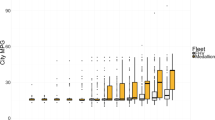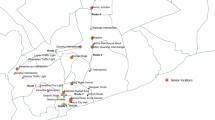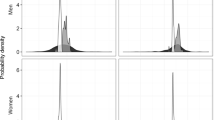Abstract
Introduction
The adverse health outcomes of traffic-related ultrafine particles (UFPs) disproportionally impact near-highway neighborhoods. Current studies focus on either short-term health outcomes associated with short-term UFP exposures averaged over days or weeks, or long-term outcomes associated with long-term (yearly or longer) average UFP exposures. We hypothesized that frequent and repeated exposure to short-term UFP peaks that last for just hours could overwhelm or alter physiological defensive responses, resulting in long-term health issues. Herein, we propose a new exposure metric for measuring the cumulative effect of these peak exposures.
Method
We used UFP exposure data estimated by the Community Assessment of Freeway Exposure and Health (CAFEH) project, which recruited 704 participants from three pairs of near-highway/urban background neighborhoods in the Greater Boston Area between 2009 and 2012. CAFEH developed land use regression (LUR) models to estimate hourly averages of ambient UFP levels within the study areas based on mobile-monitored UFP data, and applied time-activity adjustment (TAA) to calculate adjusted final hourly estimates. Our alternative metric assigns cumulative peak exposure, which is determined as either the intensity (a high percentile of an individual’s adjusted hourly UFP estimates) or the frequency (the number of hours with adjusted UFP estimates greater than a high percentile of all adjusted hourly UFP estimates of all participants in the study area) of UFP peaks.
Results
After TAA was applied, for most of the time, our cumulative peak exposure metrics were not strongly correlated with the annual average. However, the level of correlation varied greatly from neighborhood to neighborhood (Spearman’s R ranges from 0.39 to 0.97).
Conclusion
There was variation in UFP peak exposure that was not explained by the annual average, suggesting that our proposed peak metric distinct from annual average exposure metric.
This is a preview of subscription content, access via your institution
Access options
Subscribe to this journal
Receive 6 print issues and online access
$259.00 per year
only $43.17 per issue
Buy this article
- Purchase on Springer Link
- Instant access to full article PDF
Prices may be subject to local taxes which are calculated during checkout








Similar content being viewed by others
References
Zhang K, Batterman S. Air pollution and health risks due to vehicle traffic. Sci Total Environ. 2013;450-451:307–16.
Sabaliauskas K, Evans G, Jeong CH. Source identification of traffic-related ultrafine particles data mining contest. Procedia Comput Sci. 2012;13:99–107.
Baldauf RW, Devlin RB, Gehr P, Giannelli R, Hassett-Sipple B, Jung H, et al. Ultrafine particle metrics and research considerations: review of the 2015 UFP Workshop. Int J Environ Res Public Health. 2016;13:1054.
Kwon HS, Ryu MH, Carlsten C. Ultrafine particles: unique physicochemical properties relevant to health and disease. Exp Mol Med. 2020;52:318–28.
Chen R, Hu B, Liu Y, Xu J, Yang G, Xu D, et al. Beyond PM2.5: the role of ultrafine particles on adverse health effects of air pollution. Biochim Biophys Acta. 2016;1860:2844–55.
Corlin L, Ball S, Woodin M, Patton AP, Lane K, Durant JL, et al. Relationship of time-activity-adjusted particle number concentration with blood pressure. Int J Environ Res Public Health. 2018;15:2036.
Tyler CR, Zychowski KE, Sanchez BN, Rivero V, Lucas S, Herbert G, et al. Surface area-dependence of gas-particle interactions influences pulmonary and neuroinflammatory outcomes. Part Fibre Toxicol. 2016;13:64.
Karner AA, Eisinger DS, Niemeier DA. Near-roadway air quality: synthesizing the findings from real-world data. Environ Sci Technol. 2010;44:5334–44.
Tsuda A, Henry FS, Butler JP. Particle transport and deposition: basic physics of particle kinetics. Compr Physiol. 2013;3:1437–71.
Zhu Y, Hinds WC, Kim S, Sioutas C. Concentration and size distribution of ultrafine particles near a major highway. J Air Waste Manag Assoc. 2002;52:1032–42.
Su JG, Apte JS, Lipsitt J, Garcia-Gonzales DA, Beckerman BS, de Nazelle A, et al. Populations potentially exposed to traffic-related air pollution in seven world cities. Environ Int. 2015;78:82–9.
Bai L, Weichenthal S, Kwong JC, Burnett RT, Hatzopoulou M, Jerrett M, et al. Associations of long-term exposure to ultrafine particles and nitrogen dioxide with increased incidence of congestive heart failure and acute myocardial infarction. Am J Epidemiol. 2019;188:151–9.
Downward GS, van Nunen E, Kerckhoffs J, Vineis P, Brunekreef B, Boer JMA, et al. Long-term exposure to ultrafine particles and incidence of cardiovascular and cerebrovascular disease in a prospective study of a Dutch cohort. Environ Health Perspect. 2018;126:127007.
Jordakieva G, Grabovac I, Valic E, Schmidt KE, Graff A, Schuster A, et al. Occupational exposure to ultrafine particles in police officers: no evidence for adverse respiratory effects. J Occup Med Toxicol. 2018;13:5.
Tobias A, Rivas I, Reche C, Alastuey A, Rodriguez S, Fernandez-Camacho R, et al. Short-term effects of ultrafine particles on daily mortality by primary vehicle exhaust versus secondary origin in three Spanish cities. Environ Int. 2018;111:144–51.
Smith TJ. Studying peak exposure: toxicology and exposure statistics. In: Marklund S, editor. X2001 – Exposure Assessment in Epidemiology and Practice. Stockholm, Sweden: National Institute for Working Life; 2001. p. 207–9.
Ezratty V, Guillossou G, Neukirch C, Dehoux M, Koscielny S, Bonay M, et al. Repeated nitrogen dioxide exposures and eosinophilic airway inflammation in asthmatics: a randomized crossover study. Environ Health Persp. 2014;122:850–5.
Pathmanathan S, Krishna MT, Blomberg A, Helleday R, Kelly FJ, Sandstrom T, et al. Repeated daily exposure to 2 ppm nitrogen dioxide upregulates the expression of IL-5, IL-10, IL-13, and ICAM-1 in the bronchial epithelium of healthy human airways. Occup Environ Med. 2003;60:892–6.
Sundblad BM, von Scheele I, Palmberg L, Olsson M, Larsson K. Repeated exposure to organic material alters inflammatory and physiological airway responses. Eur Respir J. 2009;34:80–8.
Holz O, Mucke M, Paasch K, Bohme S, Timm P, Richter K, et al. Repeated ozone exposures enhance bronchial allergen responses in subjects with rhinitis or asthma. Clin Exp Allergy. 2002;32:681–9.
Fuller CH, Patton AP, Lane K, Laws MB, Marden A, Carrasco E, et al. A community participatory study of cardiovascular health and exposure to near-highway air pollution: study design and methods. Rev Environ Health. 2013;28:21–35.
Patton AP, Zamore W, Naumova EN, Levy JI, Brugge D, Durant JL. Transferability and generalizability of regression models of ultrafine particles in urban neighborhoods in the Boston Area. Environ Sci Technol. 2015;49:6051–60.
Padro-Martinez LT, Patton AP, Trull JB, Zamore W, Brugge D, Durant JL. Mobile monitoring of particle number concentration and other traffic-related air pollutants in a near-highway neighborhood over the course of a year. Atmos Environ. 1994;2012:253–64.
Patton AP, Perkins J, Zamore W, Levy JI, Brugge D, Durant JL. Spatial and temporal differences in traffic-related air pollution in three urban neighborhoods near an interstate highway. Atmos Environ. 2014;99:309–21.
Lane KJ, Levy JI, Scammell MK, Peters JL, Patton AP, Reisner E, et al. Association of modeled long-term personal exposure to ultrafine particles with inflammatory and coagulation biomarkers. Environ Int. 2016;92-93:173–82.
Patton AP, Collins C, Naumova EN, Zamore W, Brugge D, Durant JL. An hourly regression model for ultrafine particles in a near-highway urban area. Environ Sci Technol. 2014;48:3272–80.
Lane KJ, Levy JI, Scammell MK, Patton AP, Durant JL, Mwamburi M, et al. Effect of time-activity adjustment on exposure assessment for traffic-related ultrafine particles. J Expo Sci Env Epid. 2015;25:506–16.
Li L, Wu J, Hudda N, Sioutas C, Fruin SA, Delfino RJ. Modeling the concentrations of on-road air pollutants in southern California. Environ Sci Technol. 2013;47:9291–9.
Hoek G, Beelen R, Kos G, Dijkema M, van der Zee SC, Fischer PH, et al. Land use regression model for ultrafine particles in Amsterdam. Environ Sci Technol. 2011;45:622–8.
Lane KJ, Scammell MK, Levy JI, Fuller CH, Parambi R, Zamore W, et al. Positional error and time-activity patterns in near-highway proximity studies: an exposure misclassification analysis. Environ Health-Glob. 2013;12:75.
Jamriska M, Morawska L, Mergersen K. The effect of temperature and humidity on size Segregated traffic exhaust particle emissions. Atmos Environ. 2008;42:2369–82.
Acknowledgements
The authors would like to thank Dr. Allison Patton of Health Effects Institute, and Dr. Neelakshi Hudda, Dr. John Durant, Dr. Ken Chui, and Dr. Janet Forrester of Tufts University for their comments and suggestions throughout this study. The authors would also like to thank researchers and staff members of the CAFEH project, on which our study was based.
Funding
The authors received no financial support in conducting this study. However, the CAFEH project, where the research data came from, was funded by National Institute of Environmental Health Science (NIEHS) (Grant Nos. ES015462, ES026980, and ES030289). In addition, previous CAFEH studies on LUR models [22] and time-activity adjustment [25, 27] were also funded by Environmental Protection Agency (EPA) (Grant No. FP-917349 and FP-917203, respectively).
Author information
Authors and Affiliations
Contributions
CL conducted the analysis and was the lead writer. KL assisted with the analysis, participated in discussions, and contributed to writing the paper. JG participated in discussions and reviewed the paper. DB was the PI of the grant that funded the data collection, and he also participated in discussions and contributed to writing the paper. All authors read and approved the final paper for submission.
Corresponding author
Ethics declarations
Competing interests
The authors declare no competing interests.
Additional information
Publisher’s note Springer Nature remains neutral with regard to jurisdictional claims in published maps and institutional affiliations.
Rights and permissions
About this article
Cite this article
Lin, C., Lane, K.J., Griffiths, J.K. et al. A new exposure metric for the cumulative effect of short-term exposure peaks of traffic-related ultrafine particles. J Expo Sci Environ Epidemiol 32, 615–628 (2022). https://doi.org/10.1038/s41370-021-00397-3
Received:
Revised:
Accepted:
Published:
Issue Date:
DOI: https://doi.org/10.1038/s41370-021-00397-3



